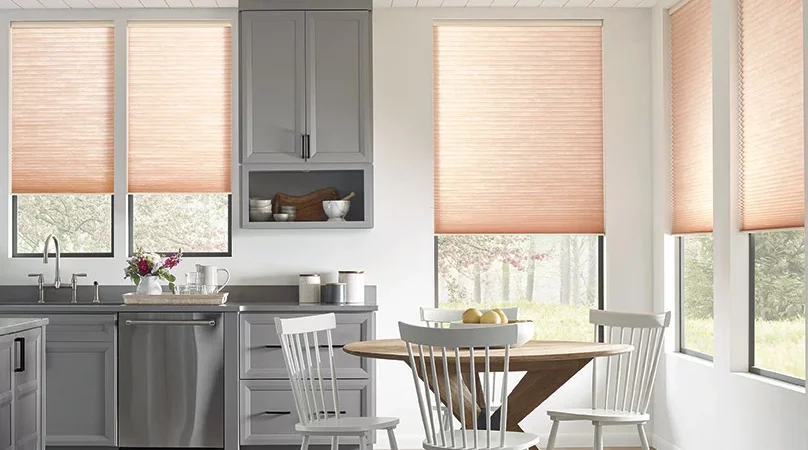Single and Double Cellular Shades Make Welcome Additions to Any Home
Honeycomb cellular shades offer all the great advantages of traditional shades and blinds for windows. They are privacy-enhancing and let you manage the amount of light that enters your home. They also offer additional advantages, the most attractive being their energy-efficient insulation properties.
Are you fed up with squandering cash out of the window for heating and cooling costs? Double or single-cell shades are the perfect solution. They are available in a wide range of shades, including light filtering and darkening room fabrics, as well as advanced lift options. So the possibilities for customization are unlimited! Let’s take a look at the benefits of cellular shades, and how to choose between single-cell shades and. double-cell shades.
What’s the Difference Between Single Cell and Double Cell Shades?
Think about the interior of a beehive, with its honeycomb structure. That’s how cell shades are made. Single-cell shades have the hexagonal cell of one row that are stacked on top of each other. Double cell shades feature 2 rows of cells that are tucked inside one another, providing an extra layer of insulation and protection.
If you’re searching for shades that provide the privacy, flexibility, and insulation you require Cellular shades will do the trick. Which is better, single shade or double?
Single Cell Shades
Single-cell shades typically are less expensive than double-cell shades. There’s less material to be used which results in shorter manufacturing time.
Also, you’ll save money over the long term. Single cellular shades offer more insulation than conventional shades. The honeycomb-like pleated material blocks sunlight and block UV radiation which means your home is warmer in winter, and cooler during the summer. This, in turn, lowers the cost of energy.
Do Double Cell Shades Block More Light Than Single Cell Shades?
Single-cell and double-cell shades are alike in their ability to block sunlight that is coming in. However, the type of material you choose will decide the amount of light your cellular shades allow in. Select cellular shades that filter light to allow diffuse natural light to flood into the space. You may also want to block out lighting completely. In this case, opt for shades that block out light.
Can Cellular Shades Reduce Outside Noise?
Due to their honeycomb design Both double cell and single-cell shades have great noise reduction capabilities. The cells absorb sound similar to the way they block air from outside. Double cell shades comprise 2 layers of cells which means they block double the amount of noise. If you reside in a crowded and noisy zone it is recommended to use double cell shades.
Are Cellular Shades Easy to Clean?
If you’re like many people, you’re afraid of cleaning your windows. Who wants to wash blinds and shades, on top of that? The good thing is that Cellular shades are simple to wash and keep clean. They are typically made of tough and anti-static materials which means that a light vacuuming or dusting periodically is all you require.
The cost of your shade will depend on the kind of fabric you pick and whether you select a motorized shade. Double-cell shades cost higher than simple-cell shades because of the additional layer of fabric. However, the double-cell shades can be well worth the cost if your home needs more insulation, and is located in a noisy area. Shades made of celluloid may not be the cheapest alternative however the savings you’ll get from your energy bills makes them a worthwhile investment.
Build Your Perfect Shade!
Let us assist you to find the perfect shade for your needs. Contact us at 800-505-19050 to speak to one of our experienced Design Consultants. We also recommend our article.

